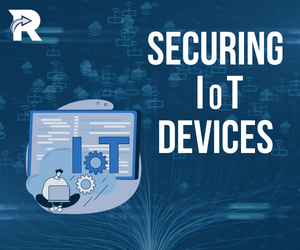
Internet of Things is a complicated issue when it comes to practicality of everyday use, especially within a business. How do we secure our IoT devices?
First, training must take place so that an understanding of what IoT is, and the implications and risks involved, is present.
“Cyberattacks are becoming more common and dangerous. IoT devices are particularly vulnerable to many types of cyberattacks because devices and systems can be accessed from anywhere in the world. Hackers can use this access to steal information or disrupt or damage the device. There are many steps that can be taken to protect an IoT device from cyberattacks. In some cases, the attacks can sabotage critical systems, leading to financial losses.” (Read Write).
These risks are increasing over time, so a comprehensive strategy is essential in running a successful IoT system.
“There is no doubt that IoT is growing exponentially, with devices being embedded in everything from cars to hospitals. With this level of growth comes the inevitable security concerns. The hard truth is IoT devices, such as other devices, are vulnerable to cyberattacks. To assess the risks and threats to IoT devices, it is important to understand the different types of attacks that can be launched against them.” (Read Write).
Some specific risks to IoT devices are malware attacks, DDoS attacks, and data breaches. One area to start with securing your IoT system is authentication.
“Many IoT-connected devices have weak authentication. Some use hardcoded passwords embedded in the product’s source code. Unfortunately, you can’t change these to a value only known to you. Some IoT devices have changeable passwords, but they’re released with factory default values. Sadly, most people don’t bother changing default passwords.” (Tech Genix).
Some more strategies for improving security include segmentation, keeping systems up to date, and encryption.
“Make sure your network is configured with appropriate firewalls, intrusion detection and prevention systems, and other security measures. Keeping IoT devices isolated from other networks would be an excellent practice to prevent attacks on IoT devices from other networks.” (Read Write). “Enabling encryption on your devices also makes it difficult for hackers to gain access to your data. If they are able to gain access to your devices, they could potentially steal your data or use it for malicious purposes. By encrypting your devices, you can help protect yourself and your data from harm.”
Overall, the better your understanding of the risks involved, the better equipped you are to secure your IoT devices.
“As the Internet of Things gains an even stronger foothold in business environments, it’s important to understand its risks. More importantly, businesses must know how to secure IoT devices, networks, and the processes that use them.” (Tech Genix).
Have any questions about cyber-security? Responsive Technology Partners is the leading cyber-security expert in the Athens, Metter, Milledgeville, Vidalia, and Atlanta, Georgia areas. We also have locations in Tampa, Florida, Roanoke, Virginia, and Raleigh South Carolina. Service offerings include I.T. support, cyber-security and compliance, telephony, cloud services, cabling, access control, and camera systems. Our company’s mission is to provide world-class customer service through industry leading I.T. solutions that make every customer feel as if they are our only customer. Please visit our website to learn more: https://www.responsivetechnologypartners.com/.
Sources:
Read Write. https://readwrite.com/what-you-need-to-know-about-the-security-of-iot-devices/
Tech Genix. https://techgenix.com/how-to-secure-iot-devices-in-your-business-using-best-practices/




